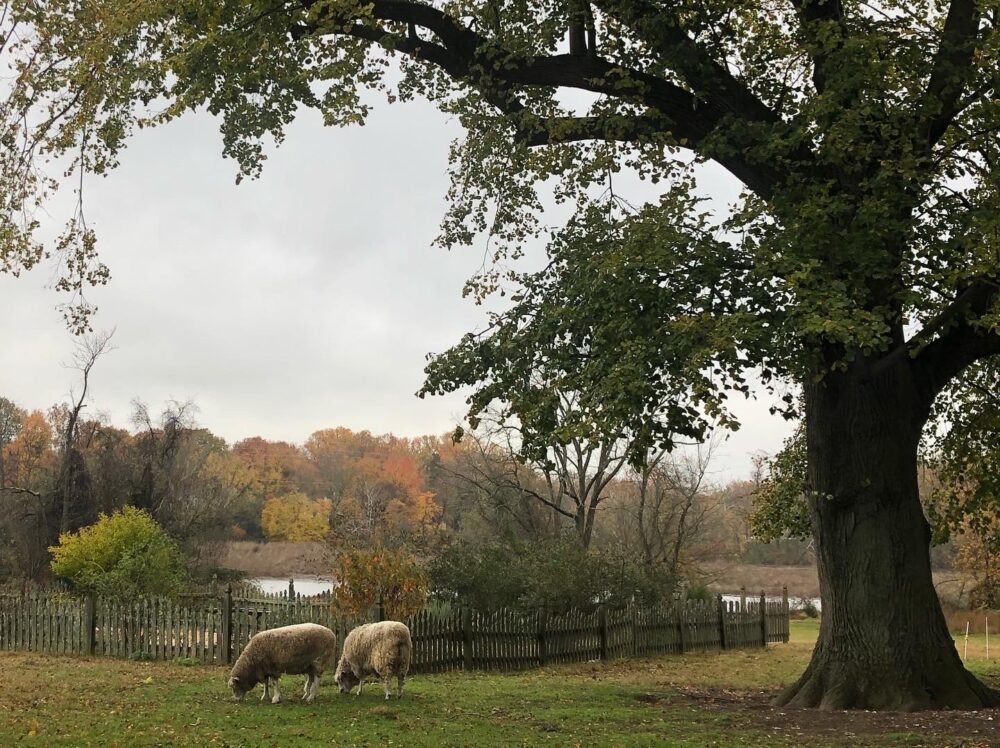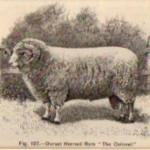The history of the Dorset Horn begins in the 16th century when valuable Spanish Merino sheep were smuggled or traded into southern England and crossed with the native horned sheep. The resultant breed, similar to the rare British Portland sheep, had the ability to breed year round. Over the next two centuries, the Portland was improved by adding Southdown blood, and ultimately yielded the Dorset Horn. The breed became quite popular in the southern English Counties of Dorset, Somerset, and Devon, and in Wales. It is believed Dorset Horns were first imported into the United States in 1860 by Richard Scott of Oregon. An English firm imported more stock into the United States in 1885 and exhibited them in Chicago. After that, numerous other individuals and farms imported varying numbers of Dorset Horns into the United States from Canada and England. By the end of the 19th century it was one of the most popular breeds of sheep in America.
In 1949 at the North Carolina State University, the first polled Dorsets appeared when a young Dorset Horn ram produced four polled (hornless) daughters. In 1954 the ram sired his first polled ram lamb. In 1956 the Continental Dorset Club (CDC), the breed association which registered the Dorset Horn, accepted the North Carolina polled strain for registration as well. With the advent of the Polled Dorset, the name Horned Dorset was used interchangeably with the old name Dorset Horn.
Since the emergence of the polled mutation in the 1950s the Polled Dorset has become the second most popular breed in the United States. By contrast, registrations of the Dorset Horn have plummeted dramatically. The advent of modern high-density livestock farming practices and wire fencing meant the horns, which had distinguished the breed but which required more space per animal than for a polled sheep, were considered a business negative by many modern livestock farmers.
In addition, modern trends in American agriculture – the quest for larger and earlier maturing stock dependent on high grain feed inputs – has impacted many breeds of livestock and poultry, including the Dorset Horn. Today, many Horned Dorset sheep bear little resemblance to the pre-1980s medium-sized production-style Horned Dorset which was bred to produce and raise lambs for market on pasture. The modern Horned Dorset, influenced both by these agricultural trends and the pressure of the show ring where larger animals usually place at the top of the class without regard for characteristics such as hardiness, longevity, and year-round reproductive ability, is noticeably taller and lighter-boned than the old style. But they don’t necessarily yield more meat than the shorter, blockier Dorset.
The traditional, production-style Dorset Horn which you can see on our farm is a medium size sheep with short, heavy-boned legs, a relatively wide muzzle, and a deep, well-muscled, long and blocky body. 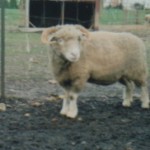
The Dorset Horn has a medium white wool of hand spinning quality. Sheared once a year it yields a fleece of between 5 and 9 pounds. Spinners who have purchased our fleeces tell us that they have found a real difference in quality between the fleece of the old production-style Horned Dorsets, which they find softer and crimpier, than that of the Polled Dorset or modern style Horned Dorset. Spinners and re-enactors also appreciate using the historically accurate Dorset Horn wool in their yarns and garments. The marketability of the Dorset Horn’s fleece is an additional source of income for the producer and something to be expected from a sheep that was developed at a time when the shepherd needed to obtain both meat and fiber from his flock.
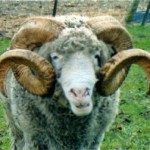 The horns are the most distinguishing and attractive physical characteristics of the Dorset Horn. Both Horned Dorset rams and ewes are horned. The ram’s horns are heavy and masculine, curving down in a spiral and forward without touching the ram’s face or jaw. As the Dorset Horn ram reaches full size in his second year, so do the ram’s horns.
The horns are the most distinguishing and attractive physical characteristics of the Dorset Horn. Both Horned Dorset rams and ewes are horned. The ram’s horns are heavy and masculine, curving down in a spiral and forward without touching the ram’s face or jaw. As the Dorset Horn ram reaches full size in his second year, so do the ram’s horns.
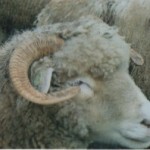 The ewes’ horns, comma shaped and forward curving, are more delicate and feminine. The horns, another marketing plus of the Dorset Horn, are sought after by collectors, by crafters who use them to make buttons or handles for walking sticks and canes, and also by those who wish to make traditional shofar horns, the traditional ram’s horn of the Bible.
The ewes’ horns, comma shaped and forward curving, are more delicate and feminine. The horns, another marketing plus of the Dorset Horn, are sought after by collectors, by crafters who use them to make buttons or handles for walking sticks and canes, and also by those who wish to make traditional shofar horns, the traditional ram’s horn of the Bible.
The Horned Dorset ram also makes a fine live mascot for any high school and college sports teams that use the ram symbol. A Horned Dorset flock can be an historically appropriate addition to period museums and historic farms. We were proud to be able to supply Dorset Horn rams to historic farm museums in Pennsylvania and New York that sought period appropriate livestock to display.
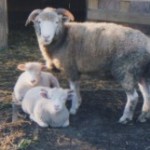 Probably the most important trait of the old style Dorset Horn for conservation purposes, however, is its year round breeding ability, thus allowing it to produce both spring and fall lambs for the shepherd to market. The Horned Dorset ram passes this characteristic on to both his purebred and crossbred daughters. Horned Dorset ewes are easy lambers, careful, doting mothers, and heavy milkers.
Probably the most important trait of the old style Dorset Horn for conservation purposes, however, is its year round breeding ability, thus allowing it to produce both spring and fall lambs for the shepherd to market. The Horned Dorset ram passes this characteristic on to both his purebred and crossbred daughters. Horned Dorset ewes are easy lambers, careful, doting mothers, and heavy milkers.
They easily produce enough milk to support twins and triplets. Their milking ability was well recognized in their native England where they would often be found in dairies. 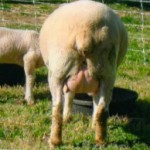
With proper food and nutrition it is possible for a production-style Dorset Horn to lamb twice per year. Ironically, some modern Dorset Horns that have been selected for characteristics such as rapid growth, early maturity, and size have lost this most important characteristic – the ability to breed year round. Our sheep are registered with the Continental Dorset Club.
We offer fleeces, tanned pelts, yarn, horns, and quilt batting from our Dorset Horn sheep.
Copyright 2013 – 2024 by Stratton Hall 1794 LLC. All rights reserved.
